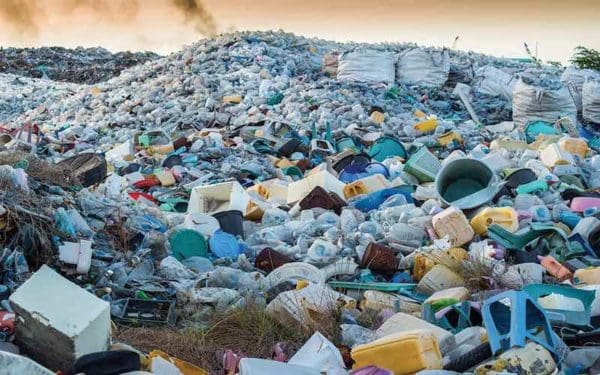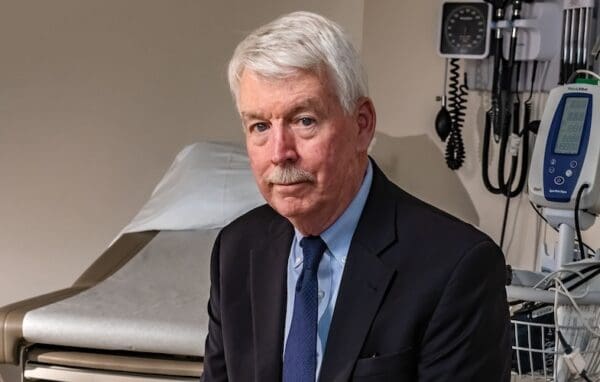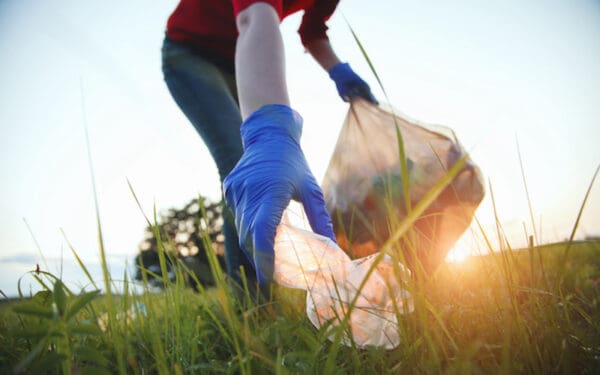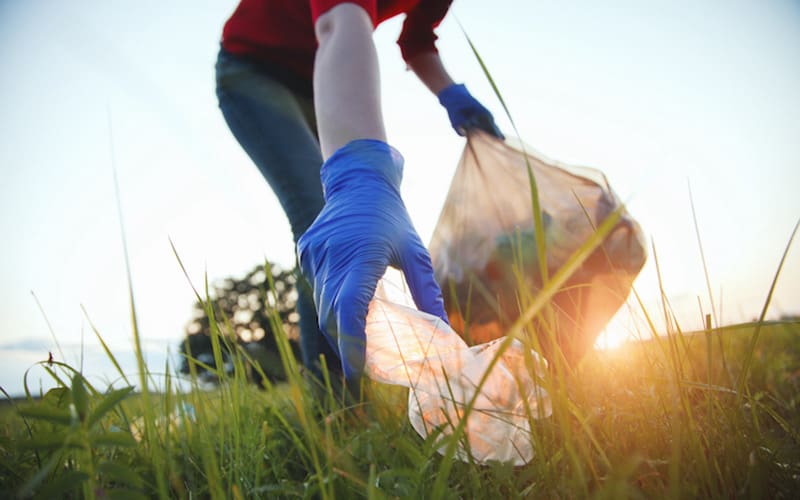
Earth Day is a time for cleaning up our environment in ways both large and small. Photo: Shutterstock
This blog post was first published in 2023 and updated with even more activities in 2025.
Earth Day is almost here! You’ve probably gotten bombarded with Earth Day activity ideas from the news and social media, but it can be hard to figure out which are the most impactful. What actually makes a difference, and what’s just greenwashing?
We’ve put together a list of Earth Day activities that pair your smaller local efforts with BIG collective actions that can really matter. Collective action is the best way to bring about real change that improves bad systems for everyone.
Here are eight ideas for Earth Day activities that’ll have the most impact:
1. Use Alternatives to Single Use Plastic
Bags, cups, straws, bottles – nearly 8.2 billion tons of plastic have been produced over the last 70 years. And most of it has ended up buried in landfills, burned in waste incinerators, or scattered throughout our neighborhoods and waterways. All that plastic comes from the same fossil fuels causing the climate crisis. Let’s stop the plastic madness.
At home, stick to reusable water bottles and reusable bags. Buy in bulk if you can. Cook at home and avoid plastic take-out containers. Avoid plastic wrap and store leftovers in reusable containers. (Glass is better — plastic containers degrade over time, emitting microplastics.)
You can have an even bigger impact by calling, tagging on social media, or emailing the companies that make your favorite products to let them know you want them to switch to recyclable, compostable, renewable, and recycled packaging.
And go one step further by asking your legislator to ban single-use plastic in your state.
2. Save North Atlantic Right Whales
Barely 370 North Atlantic right whales are left on Earth. We must do everything we can to protect this iconic species before it’s too late. While the plight of right whales may seem far removed from any action one person might take, you can make a difference.
At home, join an adopt-a-beach program, volunteer to monitor water quality, and pare back on your use of plastic products that end up in the bellies of marine animals. Slow down your boat if you’re in an area frequented by these magnificent whales, and keep a safe distance if you spot one.
To amplify your impact, write to your representatives and ask them to support action to protect right whales. Like and share posts on social media about right whales to let your friends know how they can help, too.
3. Ditch the Fossil Fuel for Clean Electricity
Too much of our region’s electricity comes from natural gas. This polluting fuel generated 55% of our electricity regionwide in 2024 alone. That means much of our electricity still comes from a dirty fossil fuel that spews the pollution causing the planet to overheat. And that explains why we’re experiencing more powerful storms, warmer winters, and hotter summers. But there are alternatives to the carbon pollution that’s harming our planet. Offshore wind and solar energy are two clean, renewable energy sources that we could use to generate electricity.
At home, if possible, switch your electricity source from fossil fuels to clean energy. At least half of electric customers have the option to purchase renewable electricity directly from their power supplier, and everyone has the option of purchasing renewable energy certificates. Clean energy programs often cost more, so talk with your utility today to find the most competitive rates.
And, you can have an even bigger impact by calling on New England’s electric grid operator to stop favoring fossil fuel projects over clean energy projects.
4. Move with Clean Transit
In New England, transportation accounts for over 40% of carbon pollution. It also spews air pollution that worsens lung and heart ailments, causes asthma attacks, and increases the risks of stroke and other health problems. The only solution is to step away from the wheel of your gas guzzler and opt for cleaner alternatives. There are some good ones out there right now, so let’s use them where possible and pressure our leaders for even more.
At home, bike, walk, or take public transit if you can. Next time you need to buy a car, check out electric options.
To take your action to the next level, write to your local leaders and transit authority to urge them to prioritize electrified, affordable, reliable public transit. Ask them to install electric vehicle charging stations in your community. And support CLF as we continue to fight for electrified public transit across New England.
5. Keep Food Waste Out of Landfills
On average, the U.S. wastes an estimated 125 to 160 billion pounds of food each year. And where does it all end up? In a landfill, where it’s buried under mounds of toxic trash and eventually emits methane gas. In fact, food waste in landfills is now the country’s third-largest source of climate-damaging methane emissions.
We can make a huge dent in our emissions simply by reducing our food waste.
At home, compost. If you have a yard, you can collect and compost your food scraps for fertilizer for your garden and houseplants. If you don’t have a yard, check to see if your community offers curbside composting services alongside regular trash collection. In areas that don’t yet have city-wide composting, many private services are picking up the slack for a monthly fee.
And if your town doesn’t have composting or a private company doesn’t fit your budget, call your town and city leaders to find out what it would take to start a pilot program.
6. Plant A Tree (And Make Sure It Thrives)
I have fond memories of an Earth Day event from my childhood when my sister and I helped water a newly planted sapling in a nearby park. When my family walks through that park more than 20 years later, my parents still refer to that now-flourishing tree as “the one that you and your sister planted.”
Planting trees can be a great way to support the environment, especially in cities. A strong tree canopy has advantages ranging from cleaner air to lower air-conditioning bills to less flooding. Joining a tree-planting event or planting a tree in your yard can benefit your whole community.
Of course, not every tree gets to grow and thrive like the one in my childhood park. Hidden dangers, like underground methane leaks, can choke the life out of a tree before it can provide all those amazing benefits. Particularly here in Boston, gas from leaking, unmaintained fossil fuel infrastructure can replace oxygen in the soil and kill off tree canopies.
If you spot a methane leak’s trademark brown circle on your lawn, you can call National Grid or your local gas provider and ask them to investigate. And if you want to prevent methane from poisoning trees (and overheating our planet at the same time!), let utility companies know it’s past time to transition away from dangerous fossil fuels to safer, renewable energy.
7. Protect Local Waterways by Cutting Down on Polluted Runoff
Fertilizers and pesticides might keep your lawn lush and green, but they can have nasty impacts on nearby waters. When stormwater runoff picks up chemicals like nitrogen and phosphorous from commercial fertilizers, it can fuel toxic algae outbreaks in rivers, ponds, and lakes. Other culprits include animal droppings, soap from washing your car, and cars leaking oil.
You can take simple steps to scale back this noxious runoff. Reduce or stop your use of pesticides and fertilizers. Pick up after your pets (a good idea regardless!). Run your car through a car wash instead of spraying it down in your driveway and keep it in good condition so it doesn’t leak oil and other pollutants. Consider a rain garden or more plants around your home to trap and filter runoff before it can reach bodies of water.
You can also help fight runoff-fueled algae outbreaks by being an environmental detective. If you spot icky green scum on the surface of your favorite watering hole, please don’t touch it – but do let us know.
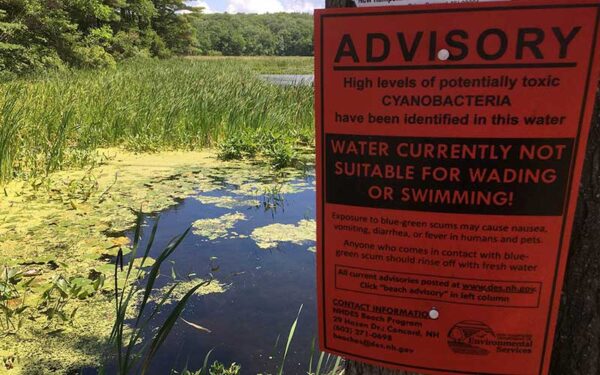
8. Put Your Time and Money Where Your Mouth Is
Noticing a theme in these posts? Making small changes as an individual is pretty straightforward – but they don’t always add up to the big changes we need for a healthier environment. But making those big changes as part of a team is a lot easier.
CLF is taking on major challenges that no single person could manage. Whether we’re suing Big Oil companies like Shell, funding sustainable and affordable housing, or successfully campaigning for laws that cut climate-damaging pollution across New England, we’re able to make changes on a major scale.
Want to get involved and help the cause today? Sign up for our emails and you’ll be the first to know when there’s an opportunity to write to your representatives, sign a petition, attend an event, or take other impactful actions. Want to help fund our work? If everyone reading this chipped in 10 bucks, our legal work would be funded for the next year.
When it comes to protecting our planet, a combination of individual and collective actions on Earth Day and every day can seed real change.

